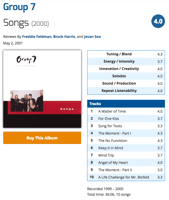Reflection Time for a Bass Singer
I wrote this blog post about singing bass in a large vocal group setting, and it ended in one of the larger a cappella blogs.
Here it is (slightly edited) in my personal space:
I’m in my fifth phase of a cappella singing. The first phase started when I was 8 years old and gave me ten years in a classical boys choir. Then a mix between classical choirs and 8 years in a 8 person a cappella group singing in a traditional jazzy Manhattan Transfer style. After that a Phase 3: 7 years with a much more personal styled pop a cappella group with our own material and arrangements. My fourth phase started when I joined Vocal Line in 2003. After five years with these great people, I decided to leave a cappella. I really believed that was it. No more a cappella for this dude. But after a three-year break, I am back with the Vocal Liners, and I have thought a lot lately on the different phases and especially the different needs you have to fulfill as a bass singer in an a cappella group compared to the large group format like Vocal Line.
From phase 3 to phase 4: Going from being a bass singer in a small format group to a large size group
When I “test-started” in Vocal Line I made an agreement with Jens Johansen, that I could “sit in” for a period of three months and he and I both had the right to end the arrangement, if we didn’t felt it would work. Good compromise for me as it had been hard to split with the a cappella group – named Group 7 – so there was a lot of emotion involved.
And boy was I lucky this was a three-month period. The transition from being the one and the only person singing a particular musical line in an arrangement to join a choir setting was mind-blowing difficult. Hey, those two or three other guys at my side were singing the same line, and it literally took me the full three months to de-learn my singing style from the smaller group. In the smaller group, you can have total focus on blending your voice with the other singers in the group and their parts. But in the large group you first have to secure blend, rhythmic feel, intonation, etc. with the others singing the same line. Especially intonation between bass singers is very tricky, as even a small detuning between three bases can set up a very insecure fundament for the rest of the choir – and at the same time really doesn’t sound that good…
It took us about half a year to set up a good sounding bass group with three 1st basses and three 2nd basses. That constellation also made it possible for us to take other roles in some arrangements; especially things like vocal percussion.
But the challenge in the bass group is, that you use a lot of mental power to keep tight together with the other bass singers and at the same time must blend with the rest of the choir, that was so easy to focus on in the small group format.
From phase 4 to phase 5: bringing the small vocal group bass sound into the choir
In my three years break away from Vocal Line the bass setting had changed. The typical setting was now two or three first basses and now only two second basses. The reason – I guess – was to make the sound more vocal group like, and it is just easier to intonate between two instead of three people. Here in-ear monitors for the second basses are crucial in a large group, large volume setting. In the first period I alternated from song to song between the two bass parts based on what would fit the arrangement (and that was also quite nice, if one of the bass singers could not take part in a concert).
But lately I have sung more and more second bass together with the one and only “Krudt”: The Second Bass in Vocal Line since 2005. The thing is, that we have established a – for me – new sound in Vocal Line. A sound that gives both a better intonation, but also a lot more freedom in our way to express the music. We have totally stolen the expression “shadowing” from jazz a cappella ensembles like the great group Touché from Copenhagen. The simple point is, that there is one second bass singer having the “lead role” and the other singer is “shadowing” the style and sound of the other. So, this is not two singers fighting at the same volume level, but they are instead working to set up one integrated sound.
The beauty of this is, that this also have established a “free space” that resembles very much the feeling I had when singing in Group 7. We can now with ease work from parts where we sing together to parts where we split in e.g. fifths (our bass signature sound at the moment, I guess) for that full-bodied bass sound or even singing entirely different lines. We have made the sound “thinner” and more vocal group like, which for closed-miked basses is no problem, as it is easily compensated via a good sound engineer.
The point in this my phase 5 is that we have brought the vocal group bass feel fully back into the large choir group setting, which at times is a magical feeling – and just really fun.

